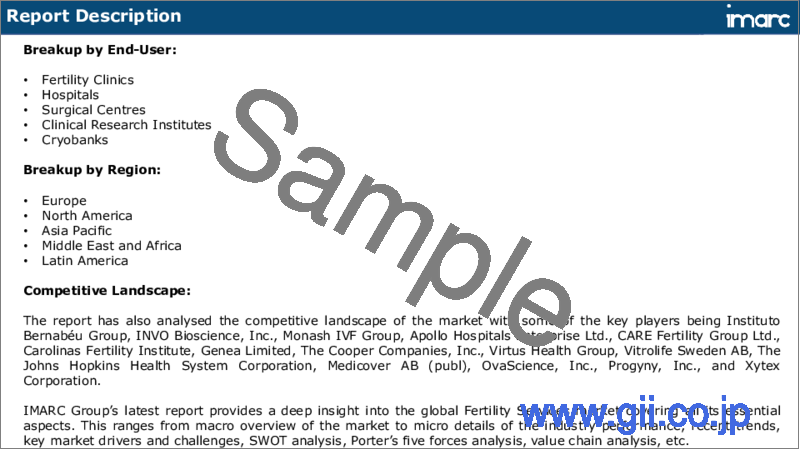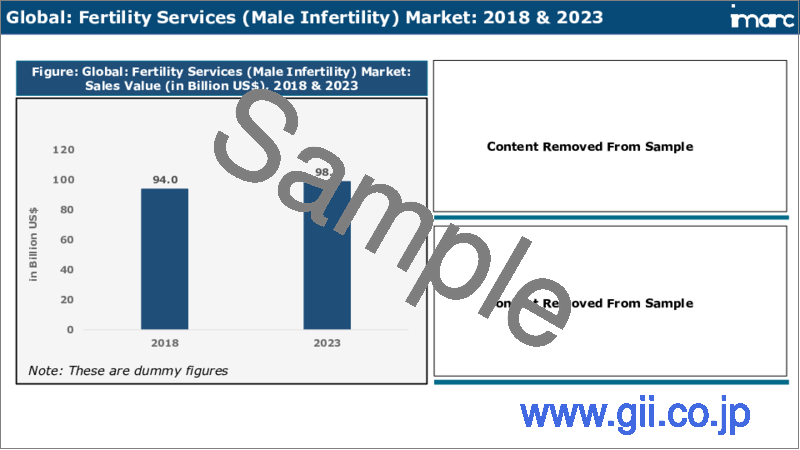|
|
市場調査レポート
商品コード
1467565
不妊治療サービス市場レポート:不妊原因、施術、サービス、エンドユーザー、地域別、2024~2032年Fertility Services Market Report by Cause of Infertility, Procedure, Service, End-User, and Region 2024-2032 |
||||||
カスタマイズ可能
|
|||||||
| 不妊治療サービス市場レポート:不妊原因、施術、サービス、エンドユーザー、地域別、2024~2032年 |
|
出版日: 2024年04月08日
発行: IMARC
ページ情報: 英文 136 Pages
納期: 2~3営業日
|
- 全表示
- 概要
- 図表
- 目次
世界の不妊治療サービス市場規模は2023年に407億米ドルに達しました。今後、IMARC Groupは、2024~2032年にかけて13.3%の成長率(CAGR)を示し、2032年までに1,295億米ドルに達すると予測しています。
不妊治療サービスとは、不妊症の治療として提供される処置を指します。不妊症とは、妊娠できないこと、または妊娠を継続できないことと定義されます。男性では、精子の数が少ないか、ホルモンのアンバランスの結果として特定されます。女性の場合、不妊症とは、卵巣から卵子が放出されるきっかけとなる脳内ホルモンを刺激する視床下部や下垂体などの腺が適切に機能していないことを指します。不妊治療には、妊娠の可能性を高める薬や処置が含まれます。不妊治療には、排卵誘発剤、人工授精、体外受精(IVF)、卵子凍結または卵子凍結保存、代理出産、生殖補助医療(ART)などが含まれます。不妊カップル、シングルペアレント、LGBTコミュニティのメンバーの家族計画を支援しています。
キャリア志向の人口基盤の拡大は、妊娠遅延の有病率の増加をもたらし、市場成長に大きく寄与しています。高額な育児サービス、学業やキャリアへの意欲、経済的安定性の欠如といった懸念のために、人々はしばしば、より成熟し経済的に確立された人生の後半に子どもを持つことを選択します。しかし、過度の仕事量とそれに伴うストレス、喫煙や薬剤の摂取を含む座りがちな生活習慣が、多くの人々の不妊問題につながっています。さらに、不妊症の原因となる子宮内膜結核、多嚢胞性卵巣症候群(PCOS)、性感染症(STD)などの様々な医療的疾患の有病率の上昇も、市場の成長を促進すると予測されています。さらに、先進経済諸国と新興経済諸国の両方において、個人間の意識の高まりと、改善された医療施設へのアクセスの向上が、これらのサービスの採用をさらに増加させています。また、可処分所得の増加や健康保険会社が提供する柔軟な適用範囲とともに、テレビやオンラインポータルサイトでの不妊治療サービスの広告・宣伝の増加といったその他の要因も、市場の成長を後押ししています。
本レポートで回答した主要質問
- 2023年の不妊治療サービスの世界市場規模は?
- 2024~2032年にかけての世界の不妊治療サービス市場の予想成長率は?
- COVID-19が世界の不妊治療サービス市場に与えた影響は?
- 不妊治療サービスの世界市場を牽引する主要要因は?
- 不妊症の原因別の不妊治療サービスの世界市場の内訳は?
- 世界の不妊治療サービスの市場内訳はどのようになっていますか?
- 不妊治療サービス世界市場のサービス別内訳は?
- 不妊治療サービスの世界市場のエンドユーザー別の区分は?
- 不妊治療サービスの世界市場における主要地域は?
- 不妊治療サービスの世界市場における主要参入企業は?
目次
第1章 序文
第2章 調査範囲と調査手法
- 調査目的
- 利害関係者
- データソース
- 一次情報
- 二次情報
- 市場推定
- ボトムアップアプローチ
- トップダウンアプローチ
- 調査手法
第3章 エグゼクティブサマリー
第4章 イントロダクション
- 概要
- 主要産業動向
第5章 世界の不妊治療サービス市場
- 市場概要
- 市場実績
- COVID-19の影響
- 市場内訳:不妊原因別
- 市場内訳:施術別
- 市場内訳:サービス別
- 市場内訳:エンドユーザー別
- 市場内訳:地域別
- 市場予測
第6章 市場内訳:不妊原因別
- 男性不妊
- 女性不妊症
第7章 市場内訳:方法別
- 顕微授精による体外受精(IVF with ICSI)
- 代理出産
- 卵細胞質内精子注入を伴わない体外受精(顕微授精を伴わない体外受精)
- 子宮内人工授精(IUI)
- その他
第8章 市場内訳:サービス別
- 新鮮非ドナー
- 冷凍非ドナー
- 卵子・胚バンク
- 新鮮ドナー
- 冷凍ドナー
第9章 市場内訳:エンドユーザー別
- 不妊治療クリニック
- 病院
- 外科センター
- 臨床研究機関
- クライオバンク
第10章 市場内訳:地域別
- 欧州
- 北米
- アジア太平洋
- 中東・アフリカ地域
- ラテンアメリカ
第11章 SWOT分析
- 概要
- 強み
- 弱み
- 機会
- 脅威
第12章 バリューチェーン分析
第13章 ポーターのファイブフォース分析
- 概要
- 買い手の交渉力
- 供給企業の交渉力
- 競合の程度
- 新規参入業者の脅威
- 代替品の脅威
第14章 価格分析
第15章 競合情勢
- 市場構造
- 主要企業
- 主要企業のプロファイル
- Instituto Bernabeu Group
- INVO Bioscience, Inc.
- Monash IVF Group
- Apollo Hospitals Enterprise Ltd.
- CARE Fertility Group Ltd.
- Carolinas Fertility Institute
- Genea Limited
- The Cooper Companies, Inc.
- Virtus Health Group
- Vitrolife Sweden AB
- The Johns Hopkins Health System Corporation
- Medicover AB(publ)
- OvaScience, Inc.
- Progyny, Inc.
- Xytex Corporation
List of Figures
- Figure 1: Global: Fertility Services Market: Major Drivers and Challenges
- Figure 2: Global: Fertility Services Market: Sales Value (in Billion US$), 2018-2023
- Figure 3: Global: Fertility Services Market: Breakup by Cause of Infertility (in %), 2023
- Figure 4: Global: Fertility Services Market: Breakup by Procedure (in %), 2023
- Figure 5: Global: Fertility Services Market: Breakup by Service (in %), 2023
- Figure 6: Global: Fertility Services Market: Breakup by End-User (in %), 2023
- Figure 7: Global: Fertility Services Market: Breakup by Region (in %), 2023
- Figure 8: Global: Fertility Services Market Forecast: Sales Value (in Billion US$), 2024-2032
- Figure 9: Global: Fertility Services Industry: SWOT Analysis
- Figure 10: Global: Fertility Services Industry: Value Chain Analysis
- Figure 11: Global: Fertility Services Industry: Porter's Five Forces Analysis
- Figure 12: Global: Fertility Services (Male Infertility) Market: Sales Value (in Billion US$), 2018 & 2023
- Figure 13: Global: Fertility Services (Male Infertility) Market Forecast: Sales Value (in Billion US$), 2024-2032
- Figure 14: Global: Fertility Services (Female Infertility) Market: Sales Value (in Billion US$), 2018 & 2023
- Figure 15: Global: Fertility Services (Female Infertility) Market Forecast: Sales Value (in Billion US$), 2024-2032
- Figure 16: Global: Fertility Services (In Vitro Fertilization with Intracytoplasmic Sperm Injection (IVF with ICSI)) Market: Sales Value (in Billion US$), 2018 & 2023
- Figure 17: Global: Fertility Services (In Vitro Fertilization with Intracytoplasmic Sperm Injection (IVF with ICSI)) Market Forecast: Sales Value (in Billion US$), 2024-2032
- Figure 18: Global: Fertility Services (Surrogacy) Market: Sales Value (in Billion US$), 2018 & 2023
- Figure 19: Global: Fertility Services (Surrogacy) Market Forecast: Sales Value (in Billion US$), 2024-2032
- Figure 20: Global: Fertility Services In Vitro Fertilization Without Intracytoplasmic Sperm Injection (IVF without ICSI) ) Market: Sales Value (in Billion US$), 2018 & 2023
- Figure 21: Global: Fertility Services (In Vitro Fertilization Without Intracytoplasmic Sperm Injection (IVF without ICSI) ) Market Forecast: Sales Value (in Billion US$), 2024-2032
- Figure 22: Global: Fertility Services (Intrauterine Insemination (IUI)) Market: Sales Value (in Billion US$), 2018 & 2023
- Figure 23: Global: Fertility Services (Intrauterine Insemination (IUI)) Market Forecast: Sales Value (in Billion US$), 2024-2032
- Figure 24: Global: Fertility Services (Other Procedures) Market: Sales Value (in Billion US$), 2018 & 2023
- Figure 25: Global: Fertility Services (Other Procedures) Market Forecast: Sales Value (in Billion US$), 2024-2032
- Figure 26: Global: Fertility Services (Fresh Non-Donor) Market: Sales Value (in Billion US$), 2018 & 2023
- Figure 27: Global: Fertility Services (Fresh Non-Donor) Market Forecast: Sales Value (in Billion US$), 2024-2032
- Figure 28: Global: Fertility Services (Frozen Non-Donor) Market: Sales Value (in Billion US$), 2018 & 2023
- Figure 29: Global: Fertility Services (Frozen Non-Donor) Market Forecast: Sales Value (in Billion US$), 2024-2032
- Figure 30: Global: Fertility Services (Egg and Embryo Banking) Market: Sales Value (in Billion US$), 2018 & 2023
- Figure 31: Global: Fertility Services (Egg and Embryo Banking) Market Forecast: Sales Value (in Billion US$), 2024-2032
- Figure 32: Global: Fertility Services (Fresh Donor) Market: Sales Value (in Billion US$), 2018 & 2023
- Figure 33: Global: Fertility Services (Fresh Donor) Market Forecast: Sales Value (in Billion US$), 2024-2032
- Figure 34: Global: Fertility Services (Frozen Donor) Market: Sales Value (in Billion US$), 2018 & 2023
- Figure 35: Global: Fertility Services (Frozen Donor) Market Forecast: Sales Value (in Billion US$), 2024-2032
- Figure 36: Global: Fertility Services (Fertility Clinics) Market: Sales Value (in Billion US$), 2018 & 2023
- Figure 37: Global: Fertility Services (Fertility Clinics) Market Forecast: Sales Value (in Billion US$), 2024-2032
- Figure 38: Global: Fertility Services (Hospitals) Market: Sales Value (in Billion US$), 2018 & 2023
- Figure 39: Global: Fertility Services (Hospitals) Market Forecast: Sales Value (in Billion US$), 2024-2032
- Figure 40: Global: Fertility Services (Surgical Centres) Market: Sales Value (in Billion US$), 2018 & 2023
- Figure 41: Global: Fertility Services (Surgical Centres) Market Forecast: Sales Value (in Billion US$), 2024-2032
- Figure 42: Global: Fertility Services (Clinical Research Institutes) Market: Sales Value (in Billion US$), 2018 & 2023
- Figure 43: Global: Fertility Services (Clinical Research Institutes) Market Forecast: Sales Value (in Billion US$), 2024-2032
- Figure 44: Global: Fertility Services (Cryobanks) Market: Sales Value (in Billion US$), 2018 & 2023
- Figure 45: Global: Fertility Services (Cryobanks) Market Forecast: Sales Value (in Billion US$), 2024-2032
- Figure 46: Europe: Fertility Services Market: Sales Value (in Billion US$), 2018 & 2023
- Figure 47: Europe: Fertility Services Market Forecast: Sales Value (in Billion US$), 2024-2032
- Figure 48: North America: Fertility Services Market: Sales Value (in Billion US$), 2018 & 2023
- Figure 49: North America: Fertility Services Market Forecast: Sales Value (in Billion US$), 2024-2032
- Figure 50: Asia Pacific: Fertility Services Market: Sales Value (in Billion US$), 2018 & 2023
- Figure 51: Asia Pacific: Fertility Services Market Forecast: Sales Value (in Billion US$), 2024-2032
- Figure 52: Middle East and Africa: Fertility Services Market: Sales Value (in Billion US$), 2018 & 2023
- Figure 53: Middle East and Africa: Fertility Services Market Forecast: Sales Value (in Billion US$), 2024-2032
- Figure 54: Latin America: Fertility Services Market: Sales Value (in Billion US$), 2018 & 2023
- Figure 55: Latin America: Fertility Services Market Forecast: Sales Value (in Billion US$), 2024-2032
List of Tables
- Table 1: Global: Fertility Services Market: Key Industry Highlights, 2023 and 2032
- Table 2: Global: Fertility Services Market Forecast: Breakup by Cause of Infertility (in Billion US$), 2024-2032
- Table 3: Global: Fertility Services Market Forecast: Breakup by Procedure (in Billion US$), 2024-2032
- Table 4: Global: Fertility Services Market Forecast: Breakup by Service (in Billion US$), 2024-2032
- Table 5: Global: Fertility Services Market Forecast: Breakup by End-User (in Billion US$), 2024-2032
- Table 6: Global: Fertility Services Market Forecast: Breakup by Region (in Billion US$), 2024-2032
- Table 7: Global: Fertility Services Market: Competitive Structure
- Table 8: Global: Fertility Services Market: Key Players
The global fertility services market size reached US$ 40.7 Billion in 2023. Looking forward, IMARC Group expects the market to reach US$ 129.5 Billion by 2032, exhibiting a growth rate (CAGR) of 13.3% during 2024-2032.
Fertility services refer to the procedures provided as a treatment for infertility. Infertility is defined as the inability to conceive or carry a full-term pregnancy. Among males, it is identified by a low sperm count or is a result of hormonal imbalance in men. For females, infertility refers to the lack of proper functioning of glands such as hypothalamus and pituitary gland that stimulate hormones in the brain to trigger the ovaries to release an egg. Fertility treatments include medications and procedures that increase the chances of pregnancy. They involve fertility drugs, artificial insemination, In Vitro Fertilization (IVF), egg-freezing or oocyte cryopreservation, surrogacy, Assisted Reproductive Technology (ART) procedures, etc. They assist infertile couples, single parents and members of the LGBT community to plan a family.
The expanding career-oriented population base has led to the increasing prevalence of delayed pregnancies, which is contributing significantly to the market growth. Owing to concerns such as expensive childcare services, academic or career ambitions, and a lack of financial stability, people often opt to have children late in life when they are more mature and financially established. However, excessive workload and the accompanying stress along with sedentary lifestyle habits including smoking and consumption of drugs lead to infertility issues among many of them. Moreover, the rising prevalence of various medical ailments such as endometrial tuberculosis, polycystic ovarian syndrome (PCOS) and sexually transmitted diseases (STDs) that can cause infertility, is also projected to catalyze the growth of the market. Additionally, growing awareness among individuals and increasing accessibility to improved healthcare facilities have further increased the adoption of these services in both developed and emerging economies. Other factors such as increasing advertising and promotion of fertility services on televisions and online portals along with the rising disposable incomes and flexible coverage offered by health insurance companies are also augmenting the market growth.
Key Market Segmentation:
IMARC Group provides an analysis of the key trends in each sub-segment of the global fertility services market report, along with forecasts at the global and regional level from 2024-2032. Our report has categorized the market based on cause of infertility, procedure, service, and end-user.
Breakup by Cause of Infertility:
Male Infertility
Female Infertility
Breakup by Procedure:
In Vitro Fertilization with Intracytoplasmic Sperm Injection (IVF with ICSI)
Surrogacy
In Vitro Fertilization Without Intracytoplasmic Sperm Injection (IVF without ICSI)
Intrauterine Insemination (IUI)
Others
Breakup by Service:
Fresh Non-Donor
Frozen Non-Donor
Egg and Embryo Banking
Fresh Donor
Frozen Donor
Breakup by End-User:
Fertility Clinics
Hospitals
Surgical Centres
Clinical Research Institutes
Cryobanks
Breakup by Region:
Europe
North America
Asia Pacific
Middle East and Africa
Latin America
Competitive Landscape:
The report has also analysed the competitive landscape of the market with some of the key players being Instituto Bernabeu Group, INVO Bioscience, Inc., Monash IVF Group, Apollo Hospitals Enterprise Ltd., CARE Fertility Group Ltd., Carolinas Fertility Institute, Genea Limited, The Cooper Companies, Inc., Virtus Health Group, Vitrolife Sweden AB, The Johns Hopkins Health System Corporation, Medicover AB (publ), OvaScience, Inc., Progyny, Inc., and Xytex Corporation.
IMARC Group's latest report provides a deep insight into the global fertility services market covering all its essential aspects. This ranges from macro overview of the market to micro details of the industry performance, recent trends, key market drivers and challenges, SWOT analysis, Porter's five forces analysis, value chain analysis, etc. This report is a must-read for entrepreneurs, investors, researchers, consultants, business strategists, and all those who have any kind of stake or are planning to foray into the fertility services market in any manner.
Key Questions Answered in This Report
- 1. What was the size of the global fertility services market in 2023?
- 2. What is the expected growth rate of the global fertility services market during 2024-2032?
- 3. What has been the impact of COVID-19 on the global fertility services market?
- 4. What are the key factors driving the global fertility services market?
- 5. What is the breakup of the global fertility services market based on the cause of infertility?
- 6. What is the breakup of the global fertility services market based on the procedure?
- 7. What is the breakup of the global fertility services market based on the service?
- 8. What is the breakup of the global fertility services market based on the end-user?
- 9. What are the key regions in the global fertility services market?
- 10. Who are the key players/companies in the global fertility services market?
Table of Contents
1 Preface
2 Scope and Methodology
- 2.1 Objectives of the Study
- 2.2 Stakeholders
- 2.3 Data Sources
- 2.3.1 Primary Sources
- 2.3.2 Secondary Sources
- 2.4 Market Estimation
- 2.4.1 Bottom-Up Approach
- 2.4.2 Top-Down Approach
- 2.5 Forecasting Methodology
3 Executive Summary
4 Introduction
- 4.1 Overview
- 4.2 Key Industry Trends
5 Global Fertility Services Market
- 5.1 Market Overview
- 5.2 Market Performance
- 5.3 Impact of COVID-19
- 5.4 Market Breakup by Cause of Infertility
- 5.5 Market Breakup by Procedure
- 5.6 Market Breakup by Service
- 5.7 Market Breakup by End-User
- 5.8 Market Breakup by Region
- 5.9 Market Forecast
6 Market Breakup by Cause of Infertility
- 6.1 Male Infertility
- 6.1.1 Market Trends
- 6.1.2 Market Forecast
- 6.2 Female Infertility
- 6.2.1 Market Trends
- 6.2.2 Market Forecast
7 Market Breakup by Procedure
- 7.1 In Vitro Fertilization with Intracytoplasmic Sperm Injection (IVF with ICSI)
- 7.1.1 Market Trends
- 7.1.2 Market Forecast
- 7.2 Surrogacy
- 7.2.1 Market Trends
- 7.2.2 Market Forecast
- 7.3 In Vitro Fertilization Without Intracytoplasmic Sperm Injection (IVF without ICSI)
- 7.3.1 Market Trends
- 7.3.2 Market Forecast
- 7.4 Intrauterine Insemination (IUI)
- 7.4.1 Market Trends
- 7.4.2 Market Forecast
- 7.5 Others
- 7.5.1 Market Trends
- 7.5.2 Market Forecast
8 Market Breakup by Service
- 8.1 Fresh Non-Donor
- 8.1.1 Market Trends
- 8.1.2 Market Forecast
- 8.2 Frozen Non-Donor
- 8.2.1 Market Trends
- 8.2.2 Market Forecast
- 8.3 Egg and Embryo Banking
- 8.3.1 Market Trends
- 8.3.2 Market Forecast
- 8.4 Fresh Donor
- 8.4.1 Market Trends
- 8.4.2 Market Forecast
- 8.5 Frozen Donor
- 8.5.1 Market Trends
- 8.5.2 Market Forecast
9 Market Breakup by End-User
- 9.1 Fertility Clinics
- 9.1.1 Market Trends
- 9.1.2 Market Forecast
- 9.2 Hospitals
- 9.2.1 Market Trends
- 9.2.2 Market Forecast
- 9.3 Surgical Centres
- 9.3.1 Market Trends
- 9.3.2 Market Forecast
- 9.4 Clinical Research Institutes
- 9.4.1 Market Trends
- 9.4.2 Market Forecast
- 9.5 Cryobanks
- 9.5.1 Market Trends
- 9.5.2 Market Forecast
10 Market Breakup by Region
- 10.1 Europe
- 10.1.1 Market Trends
- 10.1.2 Market Forecast
- 10.2 North America
- 10.2.1 Market Trends
- 10.2.2 Market Forecast
- 10.3 Asia Pacific
- 10.3.1 Market Trends
- 10.3.2 Market Forecast
- 10.4 Middle East and Africa
- 10.4.1 Market Trends
- 10.4.2 Market Forecast
- 10.5 Latin America
- 10.5.1 Market Trends
- 10.5.2 Market Forecast
11 SWOT Analysis
- 11.1 Overview
- 11.2 Strengths
- 11.3 Weaknesses
- 11.4 Opportunities
- 11.5 Threats
12 Value Chain Analysis
13 Porters Five Forces Analysis
- 13.1 Overview
- 13.2 Bargaining Power of Buyers
- 13.3 Bargaining Power of Suppliers
- 13.4 Degree of Competition
- 13.5 Threat of New Entrants
- 13.6 Threat of Substitutes
14 Price Analysis
15 Competitive Landscape
- 15.1 Market Structure
- 15.2 Key Players
- 15.3 Profiles of Key Players
- 15.3.1 Instituto Bernabeu Group
- 15.3.2 INVO Bioscience, Inc.
- 15.3.3 Monash IVF Group
- 15.3.4 Apollo Hospitals Enterprise Ltd.
- 15.3.5 CARE Fertility Group Ltd.
- 15.3.6 Carolinas Fertility Institute
- 15.3.7 Genea Limited
- 15.3.8 The Cooper Companies, Inc.
- 15.3.9 Virtus Health Group
- 15.3.10 Vitrolife Sweden AB
- 15.3.11 The Johns Hopkins Health System Corporation
- 15.3.12 Medicover AB (publ)
- 15.3.13 OvaScience, Inc.
- 15.3.14 Progyny, Inc.
- 15.3.15 Xytex Corporation






